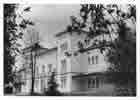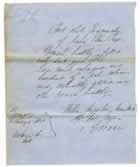Sickness
Disease was rife upon the goldfields, where poor sanitation meant that refuse and excrement were liable to end up in the rivers that supplied drinking water for those on the diggings. Dysentery, typhus and other contagious diseases were all represented. The monotonous diet of mutton and damper did not help the health of diggers, and it is probable that many people, especially during the first years of a rush, were deficient in essential nutrients and vitamins. Common colds could be lethal; because of the combination of lack of sanitation and poor diet, miners lacked the necessary antibodies to fight off disease. With a weak immune system, a cold could quickly develop into pneumonia.
With a lack of good, and in some cases any, medical facilities, even patients with serious illnesses or conditions could be returned to their tent, rather than placed in a hospital. A doctor could be called to the tent, but as medical assistance was rudimentary at best many patients died of their afflictions. The elderly and the very young were most at risk, and childbirth continued to be dangerous for both mothers and newborns.
Excessive drinking was also a major health problem on the goldfields, where hard liquor was used as a form of self-medication, to combat loneliness and other psychological afflictions. Excessive drinking could cause hardening of the liver and increase the risk of strokes or fatal collapses.
Madness
Some members of goldfields communities suffered from mental illness. Those considered ‘harmless’ were often left to care for themselves, or to the care of family or friends, and occasionally to the ministrations of the church. They were generally only incarcerated if they were considered dangerous to the safety of others or themselves, or if they had committed a crime. They would then be kept in the lock up or the gaol hospital until they could be transported to either the Yarra Bend or Kew asylums near Melbourne.
Mental health was not well understood during the gold rush era, although it was recognised as being different from other health problems. Treatment of mental illness had begun to advance in the early nineteenth century and it became less common to physically restrain the insane by chaining them to walls. Unfortunately, leg irons and straight waistcoats remained in use, though thankfully for the patients less commonly than before.
Mental illness in the early and mid-nineteenth century could be attributed to moral as well as physical causes. In theory, this meant that doctors and others who dealt with the mentally ill tried to rehabilitate them by strengthening their moral habits, working with patients’ minds, rather than trying to purge them of ill humors as was previously the case (for example by bloodletting). Doctors aimed to develop more personal relationships with mental health patients. Such ideals were not easy to carry out in the conditions of Victoria’s mental asylums. Serious overcrowding was rife in all colonial mental institutions and as a result many patients did not receive the care or consideration that was being advocated at the time. Added to this was the lack of training for those caring for the mentally unwell, which meant that the attitudes of some were closer to those of a jailer than a health professional.





